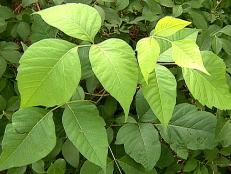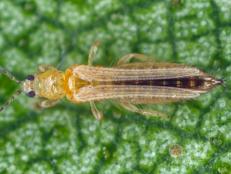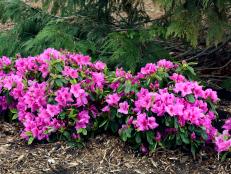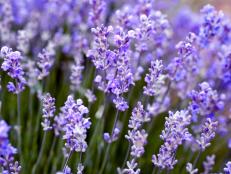How to Identify and Get Rid of Poison Oak Plants
Learn how to recognize and eradicate noxious poison oak from your landscaping.
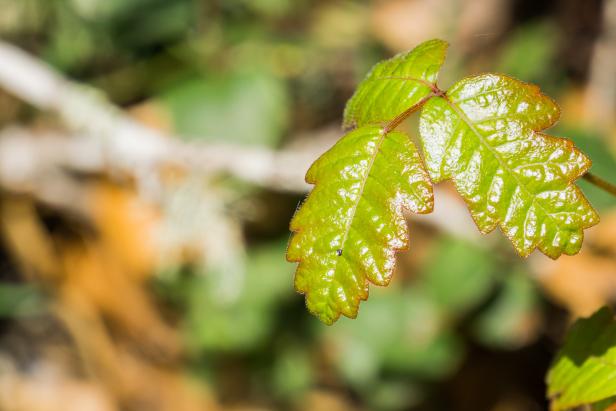
Shutterstock/ Sundry Photography
Shiny Pacific Poison oak (Toxicodendron diversilobum) leaves.
Contact with poison oak can cause an outsized amount of discomfort, but the plant doesn’t need to spoil your time outdoors. If you learn how to identify poison oak and how to safely eradicate it from your landscape, you can confidently commune with nature.
As with its relatives poison ivy (Toxicodendron radicans) and poison sumac, poison oak is avoided due to allergic reactions that include red, itchy rashes caused by contact with urushiol, an oily substance in the plant's resinous sap. According to the U.S. Forest Service, 70% to 85% of those who come in contact with the leaves, stems or roots of these plants will experience an allergic reaction. To make matters worse, contact with a pet or an item that has touched it, and even smoke from a burning poison oak plant, may also cause a reaction.
Identifying Poison Oak
In order to avoid poison oak, you'll clearly need to learn how to identify it. There are two different poison oak species that grow in separate regions of North America, and both overlap with the range of poison ivy. Knowing how to identify poison oak and poison ivy could help you avoid confusing these noxious plants with similar-looking ornamental plants such as Virginia creeper.
Eastern or Atlantic Poison Oak

Paul Cox/Wildflower.org
Atlantic poison oak
Toxicodendron pubescens grows as a ground vine or shrub to about 3 feet tall. Its range extends along the coastal plain and piedmont from the Mid-Atlantic states through the Southeast and Gulf Coast, and inland through the lower Mississippi basin.
Western or Pacific Poison Oak
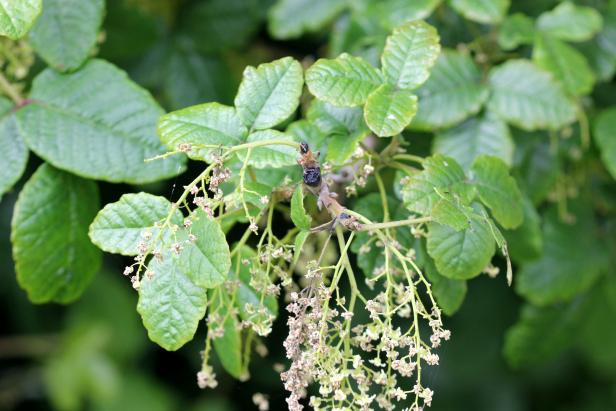
Shutterstock/Gurcharan Singh
Pacific poison oak
Toxicodendron diversilobum takes the form of a ground vine or climbing vine. It grows throughout the West Coast region from British Columbia to Mexico.
25 Poisonous Plants: Watch Out for These Bad Boys 26 Photos
Poison oak, poison ivy and poison sumac are the obvious culprits, but there are a whole host of dangerous plants out there.
"Leaflets three, leave it be" is an old, trusted mantra for identifying poison oak and poison ivy. Both poison oak species, as well as poison ivy, produce compound leaves with three leaflets each. Poison oak leaves are normally fuzzy and have the shape of a white oak leaf. They emerge in spring with a reddish tint, and quickly mature to green. In autumn, the leaves turn brilliant scarlet, orange or yellow.
Poison oak produces clusters of white flowers in mid to late spring. These are followed in midsummer by small, tan-colored fruits called drupes. In winter, the leafless cinnamon-colored poison oak stems stand erect and seem harmless, but these cause a rash just like the leaves.
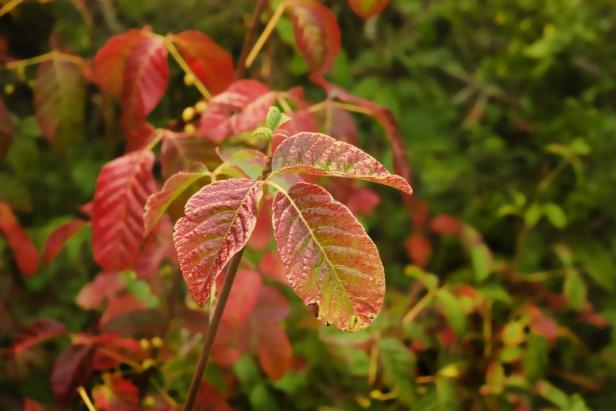
Shutterstock/Jeffrey B. Banke
Poison Oak in the late summer after it has turned color from green to the red phase
What's The Difference Between Poison Oak and Poison Ivy?
It's what the plants have in common that's most concerning: Both contain urushiol. But there are simple ways to tell these plant-cousins apart.
Poison ivy grows as a woody shrub up to 6 feet tall or a vine that can climb trees as high as 150 feet on hairy-looking aerial roots. All parts of the poison ivy plant contain urushiol. It grows in shady or sunny locations and can be found throughout the continental US, except for parts of the West Coast. Poison oak grows as a ground vine or an upright shrub about 3 feet tall in the eastern and southern US. It does not tolerate heavy shade. The poison oak variety Toxicodendron diversilobum can grow as a vine in the western US.
Leaves
As noted above, both plants have leaves consisting of three leaflets. Poison ivy leaves, which can be 2-3 inches long, can have either smooth or toothed edges. Poison oak leaves are generally about 6 inches long and are deeply toothed to resemble oak leaves and have rounder edges. Also, poison oak leaves are covered in a coating of fine hair.
Color
Poison Ivy

Pacific Poison oak

Poison ivy leaves appear as shiny green in the spring, become a dull green in the summer and then turn scarlet or yellow in autumn. Poison oak leaves are green during the spring and summer and then turn yellow with brown undertones in autumn.
How to Get Rid of Poison Oak Plants
Left alone, poison oak can climb up trees and take over landscape beds or natural areas. If it is growing in your yard, plan to eradicate it right away. The highly resilient plant grows back after mowing. Even grazing by sheep or goats won’t eliminate it.
Try these methods for getting rid of poison oak. Keep in mind that even dead plants still contain urushiol, so protect yourself with long sleeves, gloves and protective glasses while working around poison oak and disposing of debris.
Pulling & Digging
Young seedlings can be removed by simply (and carefully) digging them out with a shovel or pick. Be sure to get the entire plant — roots and all. It's easiest to remove poison oak from loose soil or in spring or fall when the soil is moist. Dispose of your uprooted poison oak plants offsite.
Note: Do not burn any parts of poison ivy, oak or sumac vines. The fumes can seriously damage your nasal passages and lungs.
Herbicides
The easiest way to kill mature poison oak is to spray it with an herbicide. Use a product that contains either glyphosate (RoundUp, etc.) or triclopyr (Garlon, Ortho Brush-B-Gon, etc.) for complete eradication. Both are broad-spectrum herbicides that will damage or kill non-targeted species as well. Follow the manufacturer’s instructions, and use caution around desirable plants.
From spring when the leaves fully expand and before the leaf color change in the fall, triclopyr kills more effectively. Glyphosate can be applied after fruiting, until the leaves begin to turn color in the fall. Either product will likely require multiple treatments to kill off established plants thoroughly.
Alternative Methods of Killing Poison Oak
Several popular natural weed control methods are ineffective when used against tough poison oak plants. Vinegar turns leaves brown, but they grow right back. Salt has a similar effect but may damage the soil for other plants as well. Smothering with weed barrier fabric, cardboard or a thick layer of mulch only redirects the vine to grow in another direction, and may in fact make the problem worse. The most reliable way to control the vine without herbicide is diligent mowing, which exposes the person who mows to the rash-causing oils. But as previously stated, poison oak will grow back after it's been cut with a mower.
Clean-Up
All clothing and tools should be immediately washed after contact with poison oak. Urushiol can remain active for months or even years. Use a degreaser, alcohol or vinegar to thoroughly remove the persistent oil.
Poison Oak Treatment
A rash from poison oak usually goes away without treatment after several weeks. Do not scratch the itchy rash. Bacteria under your fingernails might cause an infection.
To relieve itching, the US Food & Drug Administration suggests placing a wet compress over blisters on the skin or soaking the affected area in cool water. Over-the-counter (OTC) topical corticosteriods or presecription oral corticosteroids are other options.
OTC skin protectants such as calamine lotion can dry up the weeping from poison oak and ivy rashes. Baking soda and colloidal oatmeal can be used to reduce itching and irration.
The FDA says you should visit a doctor if:
- You have a temperature over 100 degrees.
- There is pus, soft yellow scabs or tenderness on the rash.
- The itching gets worse or keeps you awake at night.
- The rash spreads to your eyes, mouth, genital area or covers more than 1/4 of your skin area.
- The rash is not improving after a few weeks.
- The rash is widespread and severe.
- You have difficulty breathing.








